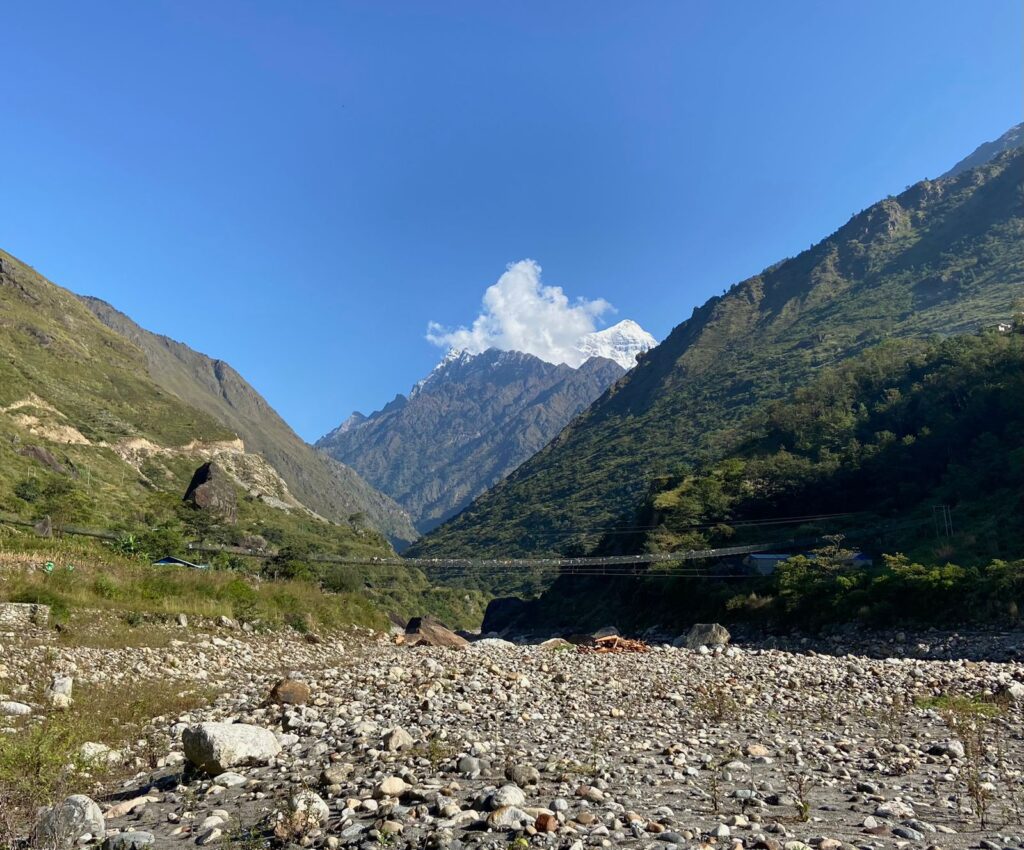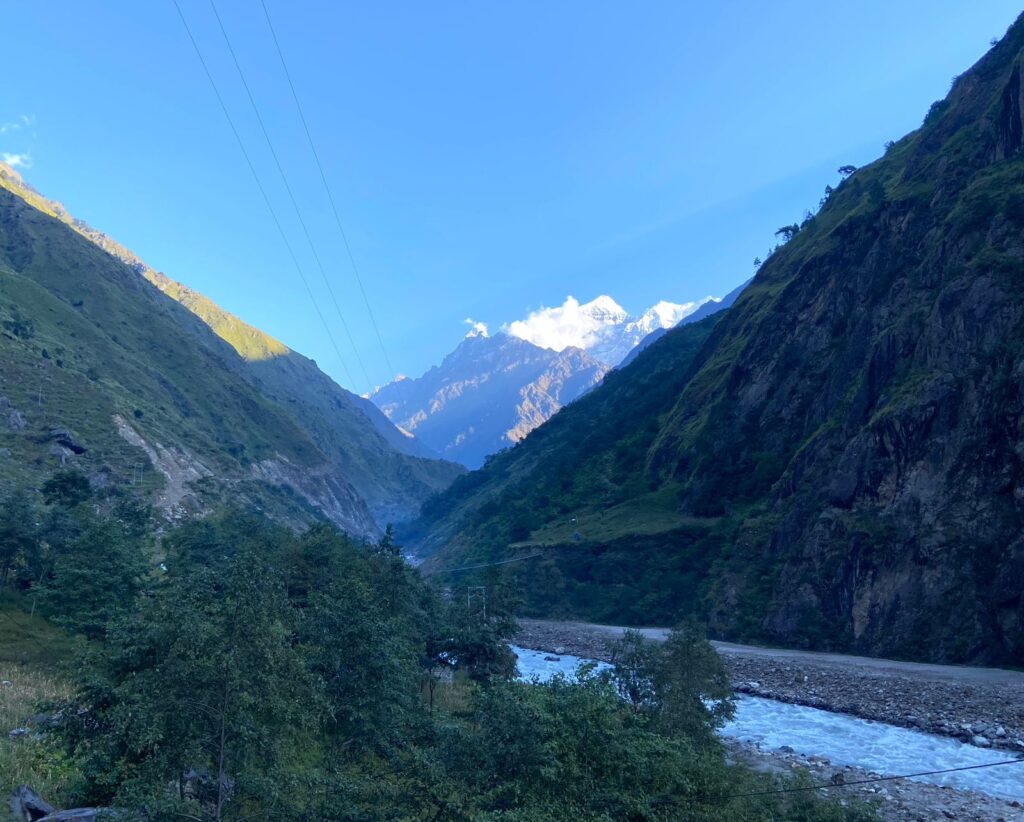Tsum Valley Trek
Be the first to review!
Overview
“Start your unforgettable journey today in Nepal’s hidden Valley of Happiness—discover sacred monasteries, vibrant Tibetan culture, and stunning mountain views on the Tsum Valley Trek.”
The Tsum Valley trek takes you to a remote Himalayan valley in northern Gorkha, Nepal, often referred to as Tsum Valley. Known as the hidden valley or the valley of happiness, it is significantly influenced by Tibetan Buddhism. This trek’s altitude ranges from 2,000 meters, reaching its highest point at Mu Gompa, which is over 4,000 meters. As a transition from the Manaslu circuit, the trails in Tsum Valley offer a quieter and more adventurous experience. Opened to trekkers in 2008, this route has preserved its authenticity, making it quite isolated and less frequented compared to more popular treks.
The region is home to the Tsumba people, who maintain a distinctive Tibetan culture characterised by ancient monasteries that preserve their dialect, customs, and art. Rich in spiritual heritage, the trek features sacred caves, mani walls, chortens, and breathtaking alpine scenery. Along the way, you’ll observe stunning views of the Ganesh Himal, Sringi Himal, and Boudha Himal ranges, making for an unforgettable experience. Also, this trek combines a spiritual and cultural journey with an adventurous Himalayan adventure, all within 13 days.
Highlights of the Trek
– Explore the sacred Mu Gompa (3,700m), one of the oldest monasteries in the area.
– Enjoy stunning views of Ganesh Himal, Himalchuli, and Shringi Himal.
– Walk alongside centuries-old mani walls, prayer wheels, and stone chortens.
– Immerse yourself in the rich Tsumba culture and traditions influenced by Tibetan heritage.
Duration, Difficulty, Accommodation, and Essentials
The Tsum Valley trek spans 13 days from arrival to departure, with 9 days dedicated to trekking. It offers a moderate level of difficulty, requiring both physical and mental fitness. While it’s suitable for both beginners and experienced trekkers, it is particularly recommended for those with some high-altitude experience due to daily hikes lasting 5 to 7 hours. Additionally, Accommodations along the trek are basic, including guesthouses, local homestays, and gompa guest rooms. Expect a limited menu and basic facilities such as shared toilets and bucket showers.
Permits Needed:
– Tsum Valley Restricted Area Permit
– Manaslu Restricted Area Permit (if combining with the Manaslu Circuit)
– Annapurna Conservation Area Permit (ACAP)
Best Time to Visit:
– Spring (March–May): Clear skies and blooming rhododendrons.
– Autumn (September–November): Incredible mountain views and local festivals.
– Avoid the monsoon season (June–August) and the depths of winter (December–February).
Why Choose This Trek
The Tsum Valley trek is ideal for travellers seeking peace and tranquillity away from crowded, commercialised routes. Further, it offers a unique blend of spirituality, culture, and adventure, allowing for a deep immersion in Tsumba communities and their rich history and traditions. Thus, this trek provides rare access to a culturally vibrant region within Nepal, marked by centuries-old monasteries and sacred caves. The trail also presents impressive views of the dramatic Himalayas and can be combined with the Manaslu Circuit for those looking for an extended adventure.
“Book your Tsum Valley Trek today and explore Nepal’s hidden Valley of Happiness!”
Itinerary Overview
Day 1: Kathmandu Arrival, Transfer to Hotel [1,330m / 25-30 minute]
Day 2: Drive from Kathmandu to Machha Khola [ 930m / 6-7 hrs. ]
Day 3: Trek to Jagat [1,340m / 5-6 hrs ]
Day 4: Trek to Lokpa [ 2,240m / 5 hrs ]
Day 5: Trek to Chumling [2,386m / 4-5 hrs ]
Day 6: Trek to Chekampar [ 3,031m / 6-7 hrs ]
Day 7: Trek to Nile [ 3,361m / 5-6 hrs ]
Day 8: Trek to Mu Gompa [ 3,700m / 6-7 hrs ]
Day 9: Trek back to Chumling [ 2,386m / 6 hrs ]
Day 10: Trek to Philim [ 1,570m / 6-7 hrs ]
Day 11: Trek to Machha Khola [ 930m / 6 hrs ]
Day 12: Drive back to Kathmandu [ 1,330m / 6-7 hrs ]
Day 13: Departure
Detail Itinerary
Kathmandu Arrival, Transfer to Hotel [1,330m / 25-30 minute]
Upon landing at Tribhuvan International Airport in Kathmandu, you will be welcomed to Nepal with a traditional garland or khata from the Trek Curator staff. After this warm reception, the team will assist you in transferring to your hotel. Shortly thereafter, your trekking guide will provide an overview of the itinerary, discuss trekking difficulties, and highlight the gear you’ll need. If you still need some trekking equipment, you can easily rent or purchase it from the shops in Thamel. In the evening, take the time to explore Thamel’s Newari architecture, bustling markets, and cosy cafes.
Drive from Kathmandu to Machha Khola [ 930m / 6-7 hrs. ]
Early in the morning, you will embark on a drive to Machha Khola, travelling along the Trishuli and Gandaki rivers. The drive features a mix of paved roads leading to Dhading and rough jeep tracks beyond Arughat. Enjoy the stunning views of terraced fields, traditional villages, waterfalls, and rolling hills. Once you arrive in Machha Khola, you’ll catch a glimpse of rural life in the area, with plenty of time to explore the village in the evening.
Trek to Jagat [1,340m / 5-6 hrs ]
Today marks the beginning of your trek as you embark on a 5 to 6-hour journey to Jagat. The trail presents a series of steep ascents and descents through lush forested hills. As you trek, you will cross suspension bridges, navigate rocky paths, and follow the Budhi Gandaki River through narrow gorges. Upon reaching Jagat, you’ll encounter a charming stone-paved village adorned with Tibetan-style homes and mani walls. Jagat serves as the entry checkpoint for the Manasalu Conservation Area, so be prepared for a permit check.
Trek to Lokpa [ 2,240m / 5 hrs ]
Your trek begins with a climb from Jagat to Salleri and Sirdibas. You’ll cross a suspension bridge in Phlim and traverse through serene pine and bamboo forests. As you take the right trail toward the Tsum Valley region, you will notice a shift from predominantly Hindu areas to a more Tibetan Buddhist landscape. After five hours of trekking, you will arrive at Lokpa, which offers a first glimpse into the hidden valley. Enjoy the tranquillity of this isolated village and have a peaceful night here.
Trek to Chumling [2,386m / 4-5 hrs ]
Today, you will descend to the Lungwa Khola and then tackle a steep climb through Ripchet to reach Chumling. The trail leads you through beautiful pine and rhododendron forests, crossing Lunguwa Khola on the way. As you arrive at Chumling, the first major village in the Tsum Valley, be sure to explore the historic Chumling Monastery (gompa), which houses ancient Tibetan scriptures and traditional mani walls. The village is characterised by stone houses with flat roofs used for drying grain.
Trek to Chekampar [ 3,031m / 6-7 hrs ]
Today, you will descend to the Lungwa Khola and then tackle a steep climb through Ripchet to reach Chumling. The trail leads you through beautiful pine and rhododendron forests, crossing Lunguwa Khola on the way. As you arrive at Chumling, the first major village in the Tsum Valley, be sure to explore the historic Chumling Monastery (gompa), which houses ancient Tibetan scriptures and traditional mani walls. The village is characterised by stone houses with flat roofs used for drying grain.
Trek to Nile [ 3,361m / 5-6 hrs ]
Today’s trek features a gradual climb through dramatic landscapes alongside the Syar Khola, leading you to Nile village. En route, you’ll pass numerous mani walls and chortens adorned with painted stones. Don’t miss a visit to Milarepa Cave, associated with the famous Tibetan yogi Milarepa, believed to have served as a meditation site in the 11th century. After trekking for 5 to 6 hours, you’ll reach Nile, one of the last permanent settlements in the upper Tsum Valley, where a few homestays are available.
Trek to Mu Gompa [ 3,700m / 6-7 hrs ]
On this day, you’ll undertake a final ascent to Mu Gompa, the highest point of your trek. The trail offers challenging, dry terrain with magnificent views of Ganesh Himal and the Tibetan plateaus. Take time to explore Mu Gompa, a spiritual highlight perched on a rocky ridge, founded in the 19th century. You might also consider a hike to the nearby Dhephu Doma Nunnery. As this is the highest sleeping point of the trek, you may experience shortness of breath or headaches, so be sure to hydrate frequently, avoid heavy meals, and refrain from alcohol.
Trek back to Chumling [ 2,386m / 6 hrs ]
From Mu Gompa, you’ll retrace your steps back to Chumling. This descent, which takes approximately 6 hours, allows you to enjoy scenic views of the trail and take better photographs of the sacred monuments you might have missed on your ascent. As you navigate through the fields and homes of locals, you’ll have the chance to interact with the Tsumbas about their traditions and Buddhist practices. Returning to lower elevations means you’ll find yourself in oxygen-rich air, with more choices available for meals and possibly even showers after your trek. Or the Everest region.
Trek to Philim [ 1,570m / 6-7 hrs ]
On Day 10, you’ll set off from Chumling and make your way to Philim. Your trek begins with a descent to Lokpa, where you’ll rejoin the Manaslu Circuit. Continuing, you’ll descend further until you reach Philim, a culturally diverse village known for its comfortable lodging. Along the trail, you can savour the warmer climate and enjoy the lush river valley scenery, complete with stunning waterfalls. Upon arriving in Philim, you’ll notice a transition back to green forests, bamboo groves, and thriving farmlands. This village is home to a well-known school funded by Japan, a Buddhist learning centre, and a small museum. In Philim, you’ll find plenty of delicious food options and improved accommodation.
Trek to Machha Khola [ 930m / 6 hrs ]
Day 11 marks your final trekking day as you retrace your steps through Jagat, Yaruphant, and Khorla Besi, heading towards Machha Khola. Along the way, you’ll cross several suspension bridges and enjoy a gentle descent through beautiful riverside farmlands. While the trail features fewer uphill sections, most of your journey will be downhill. Be sure to take in the last views of the Budhi Gandaki gorge and the breathtaking riverside cliffs. If you’re up for it, consider stopping by the Tatopani hot springs to soothe those tired muscles.
Drive back to Kathmandu [ 1,330m / 6-7 hrs ]
On Day 12, you’ll start bright and early for a long drive back to Kathmandu. The journey begins with a bumpy ride until you reach Dhading, after which the roads smooth out. Expect a few stops along the way for lunch and snacks, providing perfect opportunities to capture photos of the vibrant forests and stunning landscapes. Once you arrive in Kathmandu, you can unwind at your hotel or treat yourself to a massage or sauna in Thamel. Don’t forget to explore the area for some souvenir shopping before your last evening, which will feature a farewell dinner complete with a cultural show and local delicacies
Departure
On your final day, depending on your flight schedule, our representative will come to your hotel to assist with checkout and take you to Tribhuvan International Airport. You’ll depart with a heart full of unforgettable memories of the sacred Tsum Valley. As a keepsake, consider picking up handicrafts such as prayer flags, pashmina, yak wool scarves, and Thangka paintings. If you wish, you can also extend your trip to explore Pokhara, Chitwan, Lumbini, or even the Everest region.



